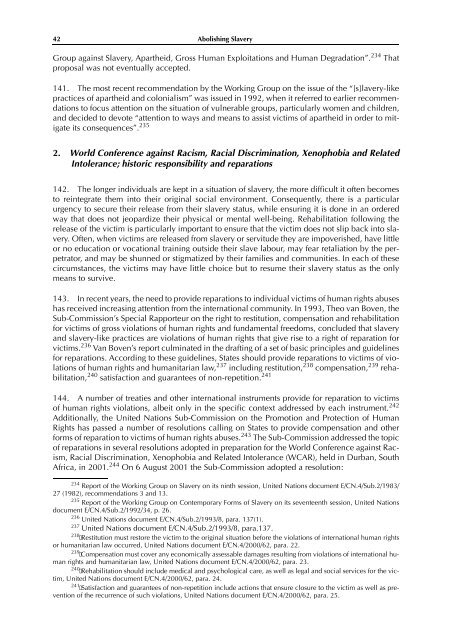Slavery in The 21st Century
Slavery in The 21st Century
Slavery in The 21st Century
You also want an ePaper? Increase the reach of your titles
YUMPU automatically turns print PDFs into web optimized ePapers that Google loves.
42 Abolish<strong>in</strong>g <strong>Slavery</strong><br />
Group aga<strong>in</strong>st <strong>Slavery</strong>, Apartheid, Gross Human Exploitations and Human Degradation”. 234 That<br />
proposal was not eventually accepted.<br />
141. <strong>The</strong> most recent recommendation by the Work<strong>in</strong>g Group on the issue of the “[s]lavery-like<br />
practices of apartheid and colonialism” was issued <strong>in</strong> 1992, when it referred to earlier recommendations<br />
to focus attention on the situation of vulnerable groups, particularly women and children,<br />
and decided to devote “attention to ways and means to assist victims of apartheid <strong>in</strong> order to mitigate<br />
its consequences”. 235<br />
2. World Conference aga<strong>in</strong>st Racism, Racial Discrim<strong>in</strong>ation, Xenophobia and Related<br />
Intolerance; historic responsibility and reparations<br />
142. <strong>The</strong> longer <strong>in</strong>dividuals are kept <strong>in</strong> a situation of slavery, the more difficult it often becomes<br />
to re<strong>in</strong>tegrate them <strong>in</strong>to their orig<strong>in</strong>al social environment. Consequently, there is a particular<br />
urgency to secure their release from their slavery status, while ensur<strong>in</strong>g it is done <strong>in</strong> an ordered<br />
way that does not jeopardize their physical or mental well-be<strong>in</strong>g. Rehabilitation follow<strong>in</strong>g the<br />
release of the victim is particularly important to ensure that the victim does not slip back <strong>in</strong>to slavery.<br />
Often, when victims are released from slavery or servitude they are impoverished, have little<br />
or no education or vocational tra<strong>in</strong><strong>in</strong>g outside their slave labour, may fear retaliation by the perpetrator,<br />
and may be shunned or stigmatized by their families and communities. In each of these<br />
circumstances, the victims may have little choice but to resume their slavery status as the only<br />
means to survive.<br />
143. In recent years, the need to provide reparations to <strong>in</strong>dividual victims of human rights abuses<br />
has received <strong>in</strong>creas<strong>in</strong>g attention from the <strong>in</strong>ternational community. In 1993, <strong>The</strong>o van Boven, the<br />
Sub-Commission’s Special Rapporteur on the right to restitution, compensation and rehabilitation<br />
for victims of gross violations of human rights and fundamental freedoms, concluded that slavery<br />
and slavery-like practices are violations of human rights that give rise to a right of reparation for<br />
victims. 236 Van Boven’s report culm<strong>in</strong>ated <strong>in</strong> the draft<strong>in</strong>g of a set of basic pr<strong>in</strong>ciples and guidel<strong>in</strong>es<br />
for reparations. Accord<strong>in</strong>g to these guidel<strong>in</strong>es, States should provide reparations to victims of violations<br />
of human rights and humanitarian law, 237 <strong>in</strong>clud<strong>in</strong>g restitution, 238 compensation, 239 rehabilitation,<br />
240 satisfaction and guarantees of non-repetition. 241<br />
144. A number of treaties and other <strong>in</strong>ternational <strong>in</strong>struments provide for reparation to victims<br />
of human rights violations, albeit only <strong>in</strong> the specific context addressed by each <strong>in</strong>strument. 242<br />
Additionally, the United Nations Sub-Commission on the Promotion and Protection of Human<br />
Rights has passed a number of resolutions call<strong>in</strong>g on States to provide compensation and other<br />
forms of reparation to victims of human rights abuses. 243 <strong>The</strong> Sub-Commission addressed the topic<br />
of reparations <strong>in</strong> several resolutions adopted <strong>in</strong> preparation for the World Conference aga<strong>in</strong>st Racism,<br />
Racial Discrim<strong>in</strong>ation, Xenophobia and Related Intolerance (WCAR), held <strong>in</strong> Durban, South<br />
Africa, <strong>in</strong> 2001. 244 On 6 August 2001 the Sub-Commission adopted a resolution:<br />
234 Report of the Work<strong>in</strong>g Group on <strong>Slavery</strong> on its n<strong>in</strong>th session, United Nations document E/CN.4/Sub.2/1983/<br />
27 (1982), recommendations 3 and 13.<br />
235 Report of the Work<strong>in</strong>g Group on Contemporary Forms of <strong>Slavery</strong> on its seventeenth session, United Nations<br />
document E/CN.4/Sub.2/1992/34, p. 26.<br />
236 United Nations document E/CN.4/Sub.2/1993/8, para. 137(1).<br />
237 United Nations document E/CN.4/Sub.2/1993/8, para.137.<br />
238 Restitution must restore the victim to the orig<strong>in</strong>al situation before the violations of <strong>in</strong>ternational human rights<br />
or humanitarian law occurred, United Nations document E/CN.4/2000/62, para. 22.<br />
239 Compensation must cover any economically assessable damages result<strong>in</strong>g from violations of <strong>in</strong>ternational human<br />
rights and humanitarian law, United Nations document E/CN.4/2000/62, para. 23.<br />
240 Rehabilitation should <strong>in</strong>clude medical and psychological care, as well as legal and social services for the victim,<br />
United Nations document E/CN.4/2000/62, para. 24.<br />
241 Satisfaction and guarantees of non-repetition <strong>in</strong>clude actions that ensure closure to the victim as well as prevention<br />
of the recurrence of such violations, United Nations document E/CN.4/2000/62, para. 25.

















